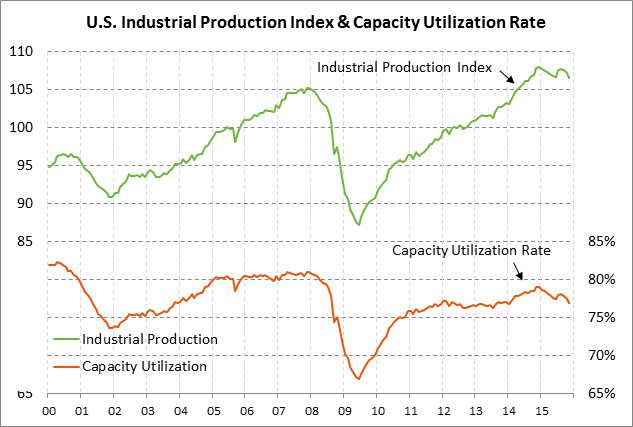- Dec retail sales expected to show a lackluster +0.2% increase ex-autos
- Jan U.S. consumer sentiment index is expected to be unchanged
- U.S. PPI expected to remain weak
- Industrial production expected to show another decline
- Empire manufacturing index expected to remain in negative territory
- Business inventories expected to show negligible decline
Dec retail sales expected to show a lackluster +0.2% increase ex-autos — The market is expecting a generally weak U.S. retail sales report today with a headline decline of -0.1% and a small +0.2% increase ex-autos. It has already been reported that vehicle sales in December fell fairly sharply to 17.22 million units from 18.05 million units in November and from the 10-1/3 year high of 18.12 million units posted in October. Retail sales in November were mildly positive at +0.2% headline, +0.4% ex-autos, and +0.5% ex-autos and gasoline. The weakness in gasoline prices continues to depress the headline retail sales figure. In November, headline retail sales rose by only +1.5% y/y, but retail sales excluding autos and gasoline rose by a much stronger +3.5% y/y.
Today’s expected Dec retail sales ex-autos figure of +0.2% would indicate a relatively lackluster holiday selling season where consumers once again focused on bargains and refused to over-extend themselves. U.S. consumers seem to be in no mood to go on a shopping spree given continued risks in the economy and modest consumer income growth.
Jan U.S. consumer sentiment index is expected to be unchanged — The market is expecting today’s preliminary-Jan University of Michigan U.S. consumer sentiment index to be unchanged at 92.6, stalling after December’s +1.3 point rise to 92.6. U.S. consumer sentiment fell to a 14-month low of 87.2 in September but then rose by a total of +5.4 points in the last three months of 2015 to post a 5-month high of 92.6 in December. The index in December was still -5.5 points below the 12-year high of 98.1 posted in Jan 2015.
U.S. consumer sentiment improved in late 2015 due to (1) stock market strength, (2) a relatively strong labor market, (3) improved consumer income (Dec hourly earnings rose +2.5% y/y), and (4) low gasoline prices. However, U.S. consumer sentiment is likely to fade in early 2016 given the fresh Chinese turmoil and the U.S. stock market correction.
U.S. PPI expected to remain weak — The market is expecting today’s PPI report to indicate continued weakness in prices at the wholesale level of the economy. The market is expecting today’s Dec final-demand PPI to improve slightly to -1.0% y/y from -1.1% in November, but for the core PPI to weaken slightly to +0.3% y/y from Nov’s +0.5%. The weakness in PPI prices is due to the sharp drop in fuel and commodity prices, combined with weak demand in the U.S. manufacturing sector.
The overall U.S. inflation outlook remains weak. The U.S. core PCE deflator in November of +1.3% y/y was well below the Fed’s +2.0% inflation target and remained at the 4-1/2 year low seen all this year. There is no sign at present of any upward momentum in core inflation and that means that the Fed is not under any imminent pressure to raise interest rates another notch.
Industrial production expected to show another decline — The market is expecting today’s Dec industrial production report to show a decline of -0.2%, adding to November’s decline of -0.6%. On a year-on-year basis, U.S. industrial production fell by -1.2% y/y, the first negative report since Dec 2009. However, part of the weakness in the industrial production report was due to mild weather in late 2015, which resulted in lower heating demand and lower utility output.
The manufacturing sector was unchanged m/m in December and showed a mildly positive gain of +0.9% y/y, suggesting that the U.S. manufacturing sector is teetering on the edge of recession. The ISM manufacturing index has fallen for the last six straight reporting months by a total of -5.3 points to post a new 6-1/2 year low of 48.2 in December. In addition, the ISM manufacturing index was below the expansion-contraction level of 50.0 in Nov-Dec, indicating that there is net pessimism among manufacturing executives.
Empire manufacturing index expected to remain in negative territory — In the first look at regional manufacturing confidence for January, the market is expecting today’s Jan Empire manufacturing index to show a small +0.59 point gain to -4.00. That small gain would add to December’s +6.15 point gain to -4.59 but would leave the index in negative territory for the sixth straight month. The New York, Philadelphia, Kansas City, and Dallas business confidence indexes were all in negative territory in December, and the Richmond district was the only district with a positive index. Business confidence remains in negative shape due to overseas risks, recessionary conditions in the U.S. manufacturing and petroleum sectors, and poor U.S. export prospects.
Business inventories expected to show negligible decline — The market is expecting today’s Nov business inventories report to show a small decline of -0.1% m/m following October’s report of unchanged. U.S. business inventories progressively rose during 2015 and reached a 6-year high of 1.38 months in the latest reporting month of October. The moderate inventory bulge is putting a dent in new orders and production since businesses first need to draw down existing inventories before they order new goods for their shelves. The need to draw down inventories subtracted -0.71 points from Q3 GDP and is expected to subtract from Q4 GDP as well.






